The great state of Iowa is famous for its agricultural significance, pork production, creation of tech giants such as Pinterest, and revolutionary foods such as taco pizza, snickers salad, and even sour cream raisin pie.
However, Iowa state symbols perhaps reflect the most noteworthy achievements of the state, both past and present.
Iowa first began to adopt its own official state symbols in 1847. Many more have been adopted since then, and a state symbol can come in the form of state animals, mammals, a state bird and flower, fruits, vegetables, amphibians, nicknames, state seals, and much more.
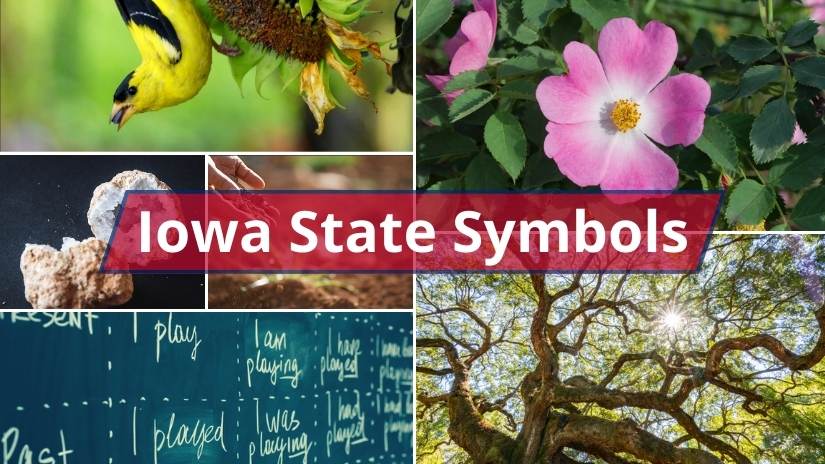
State symbols were adopted by states to best represent them and their historical roots and past and present successes. Like all other states, several Iowa state symbols epitomize the state.
Below is our Iowa state symbols and emblem list, which contains all 14 Iowa state symbols. In addition to the list below, you can find Iowa’s symbols in a table format located at the bottom of the page.
State Symbols of Iowa List
There are many state symbols of Iowa that have created an abundance of interesting facts, both from the past and present.
We have created a detailed list of the 14 Iowa state symbols below, including their images and some text detailing how and why they became an official, or non-official Iowa state symbol or emblem.
Iowa State Bird and Flower
It was in 1933 when the beautiful eastern goldfinch (Carduelis tristis) was adopted as the official state bird of Iowa! The bird also goes by the name of American goldfinch or wild canary. They can be found residing all over Iowa, often remaining in the state during the winter months too.
Fortunately, unlike many birds in North America, these goldfinches are not endangered, and there are an estimated 42 million currently. Their diet mostly consists of seeds from dandelions, sunflowers, ragweed, and evening primrose.
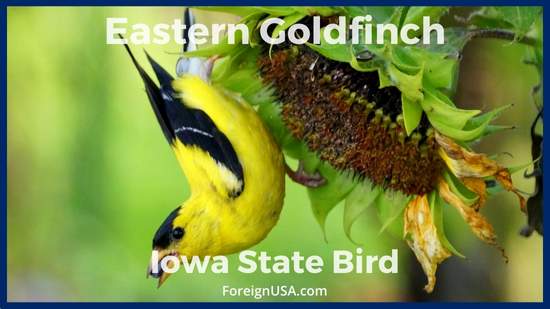
The wild rose was initially adopted as the Iowa state flower in 1897; however, there were no specific rose species that had been assigned to Iowa as the state flower until the wild prairie rose (Rosa Pratincola) years later.
Typically, wild roses will bloom from June until the late summer throughout the state. This stunning flower produces diverse colors, including shades of pink, yellow, red, and more.

Iowa State Soil
Iowa, unlike most states, doesn’t have the conventional state symbols, far from it. There are no state animals, mammals, or insects; in fact, there are not many Iowa state symbols at all! Unusually, there is a state soil used to represent the state of Iowa.
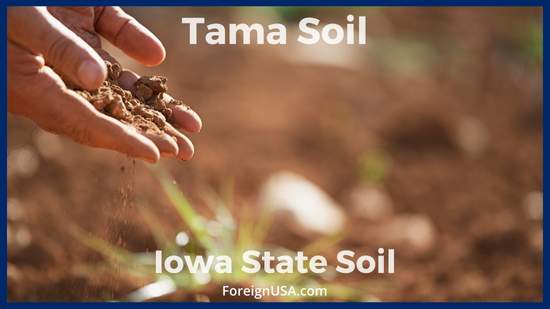
Tama soil was originally chosen to represent Iowa as the state soil as it is considered by many to be the most productive soil in Iowa for agriculture, which has helped build the state economy up over the years. There are approximately 825,000 acres containing Tama soil in eastern Iowa.
Iowa State Seal
The great state seal of Iowa is incredibly historical and symbolic of the state. There is much going on within the image – the center of the seal is occupied by a citizen soldier standing in the middle of a wheat field whilst surrounded by industrial and agricultural tools, paying homage to Iowa’s most successful early industries.
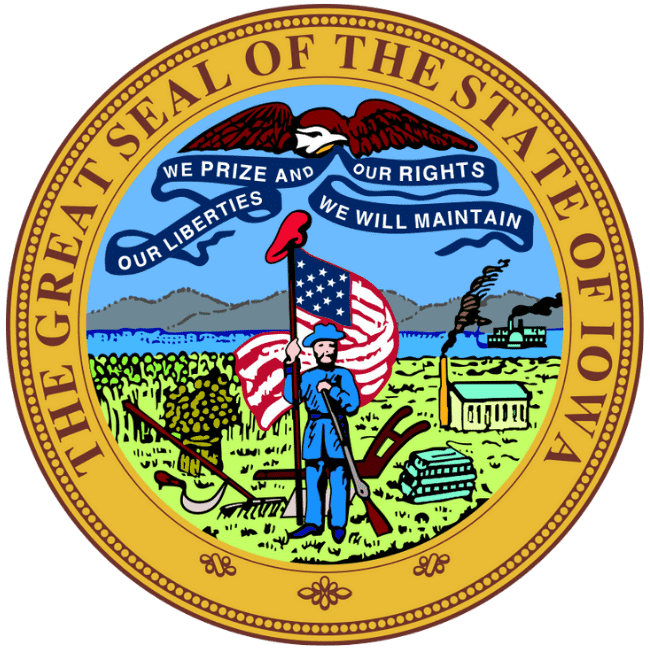
You can also see the iconic Mississippi River in the background, with a large eagle above holding up the official state motto. The eagle does not only appear here but also on the Iowa state flag. The official state seal of Iowa was created as a result of the first state Legislature back in 1847!
Iowa State Rock
The geode became the official state rock of Iowa back in 1967 to promote tourism within the state since they are found in abundance across Iowa. The state has gained a rather large international reputation for the vast number of geodes produced.
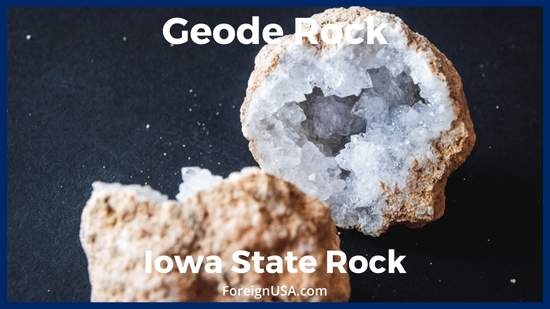
Many geode collectors still go to Iowa in search of geodes, with one of the best areas in the state being around Koekuk. People collect and sell them, to then be found in museums all across the world. If you are interested in finding geodes in Iowa, you should check out the popular geode locations across the state.
Iowa State Language
This Iowa state symbol is rather straightforward – the state made English the official state language in 2002 to try and encourage the citizens of the state to improve and eventually master the English language. The state’s former governor, Mr. Tom Vilsack, signed into law the Iowa English Language Reaffirmation Act, which meant that all official documents should be written in English.

Iowa State Tree
The Oak tree is the official tree of Iowa and has been since 1961 as well as being the national tree of the United States. This tree was picked to represent the state of Iowa due to the sheer numbers across the state – oak trees are incredibly prevalent in Iowa.
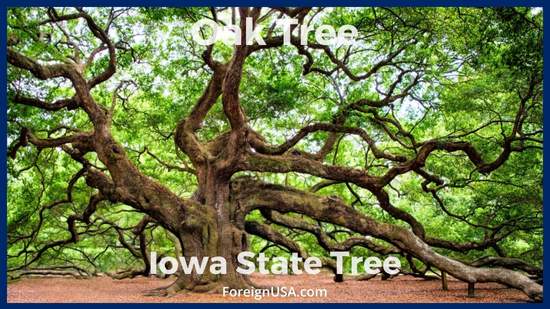
Not only this, but oak trees provide shelter, food, and nesting for many of the state’s animals and wildlife.
Iowa State Flag
On March 29, 1921, the Iowa state flag that you see today was officially adopted by the state. The flag consists of three main colors, blue, white, and red. These colors are unequal and vertical.
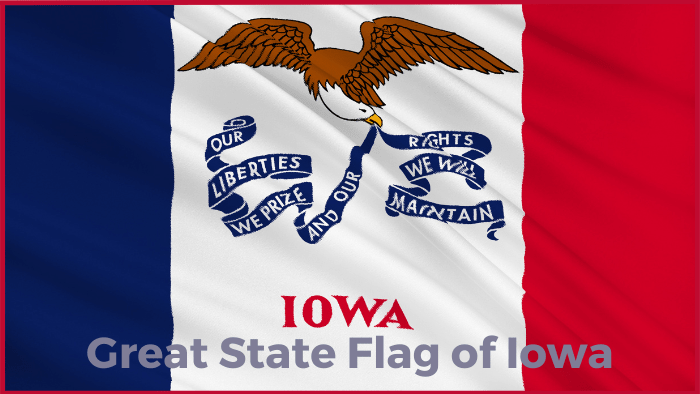
What do the symbols on the Iowa flag mean? As you will see in the graphic of the flag above, the white color in the center is the widest of the tricolored stripes and displays an eagle charged with blue streamers in its beak, inscribing the following words “Our Liberties We Prize and Our Rights We Will Maintain”. On either side of this are blue and red stripes.
Below both the eagle and streamers, you will see the word “Iowa” written in red.
The meaning of this is that the blue stripes stand for loyalty, justice, and truth, while the white stripe stands for purity, and the red stripe is for courage.
Iowa State Capitol and Capital City
Iowa’s state capitol, typically referred to as the “Iowa Statehouse” is located within the capital city of Des Moines, which has been the capital of Iowa since 1857. This building often houses some of the most influential people within the state.
The Iowa Senate, Iowa House of Representatives, the Office of the Governor, and the Offices of the Attorney General, Auditor, Treasurer, and Secretary of State all have seats in the Iowa General Assembly.

A chamber also features in the building, for the Iowa Supreme Court, however, court activities will usually take place in the neighboring Iowa Supreme Court building.
The Capitol building itself was constructed between the years 1871 and 1886, and is the only state Capitol building in the United States to feature five domes!
Iowa State Motto
The Iowa state motto is as follows, “Our liberties we prize and our rights we will maintain”, and was created via the work of a Senate committee consisting of three senates.

Also, this motto was added to the official state seal, which you can see further up the page, upon their suggestion. Not only this, but you can see the motto featured on the state flag too.
This motto resonates with many people from the state, both past and present, and represents them and their values extremely well.
Iowa State Name (Original)
The name Iowa originates from the Native Indian American word “Iowas”, or “Ioways” which the Sioux Tribe used to describe the Iowa River.
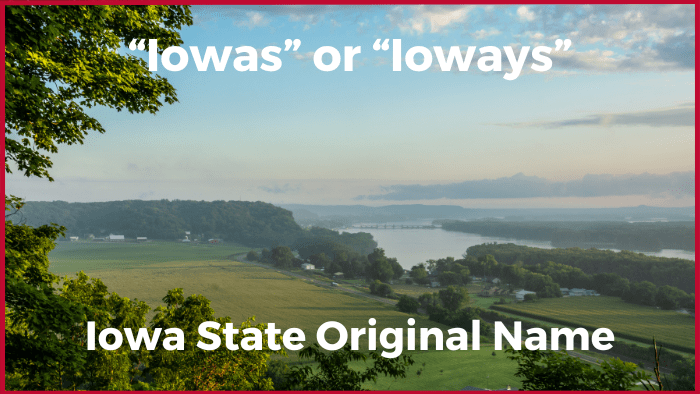
Iowa Indians, who populated the territory had the tribal name “Ayuxwa” which was spelled by the French as “Ayoua” and by the English as “Ioway”. The name “Ayoua” actually means “one who puts to sleep”.
Iowa State Nickname
Iowa’s state nickname is the “Hawkeye State” and was adopted in 1838 after paying tribute to Chief Black Hawk, a native American leader of the historically notorious, Sauk tribe.
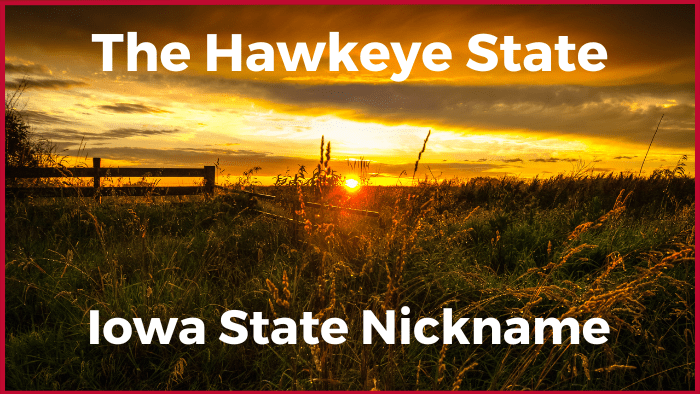
There are a few different theories behind the adoption of this nickname, not just paying tribute to the infamous tribe, despite them being one of the most notorious Native American tribes in the nation’s history.
You should take a closer look at these theories by checking out our detailed guide, which takes you through all there is to know about the Iowa state nickname and its adoption.
Iowa State Quarter
The Iowa state quarter was the fourth U.S. quarter to be released in 2004, however, Iowa’s was more specifically released on August 30. This quarter was subsequently the 29th coin released in the “50 State Quarters Program”.

This quarter showcases a one-room schoolhouse with a group of students and a teacher planting a tree, with the words “Foundation in Education” inscribed at the top, and “Grant Wood” at the bottom.
The design is based on Arbor Day, which is a painting made by Grant Wood, who was a famous artist, born near Anamosa, Iowa.
Iowa State Song
Song of Iowa is the official state song, which probably doesn’t come as much of a surprise! It was adopted in 1911 after being written in 1867 by S. H. M. Buyers. The song is all about Buyers’ love and praise for his state of Iowa.

The song was sung to the music of “Tannenbaum”, and the lyrics are as follows:
“You asked what land I love the best, Iowa, tis Iowa,
The fairest State of all the west, Iowa, O! Iowa,
From yonder Misissippi’s stream
To where Missouri’s waters gleam
O! fair it is as poet’s dream, Iowa, in Iowa.
See yonders fields of tasseled corn, Iowa in Iowa,
here plenty fills her golden horn, Iowa in Iowa,
See how her wonderous prairies shine.
To yonder sunset’s purpling line,
O! happy land, O! land of mine, Iowa, O! Iowa.
And she has maids whose laughing eyes, Iowa, O! Iowa.
To him whose loves were Paradise, Iowa, O! Iowa
O! happiest fate that e’er was known.
Such eyes to shine for one alone,
To call such beauty all his own. Iowa, O! Iowa
Go read the story of thy past. Iowa, O! Iowa
What glorious deeds, what fame thou hast! Iowa, O! Iowa
So long as time’s great cycle runs,
Or nations weep their fallen ones,
Thou’lt not forget thy patriot sons, Iowa, O! Iowa”
Buyers fought in the American Civil War for the Union but was captured by the Confederacy in 1863. It was whilst in jail that he wrote and created the iconic song of Iowa that we know today.
All Iowa State Symbols Table
The table below displays all 14 of the Iowa state symbols. As you can see, not only have we displayed the symbol, but the date on which the symbol was officially adopted:
| Type Of Symbol | State Symbol | Year |
|---|---|---|
| Iowa State Bird | American Goldfinch | 1933 |
| Iowa State Flag | Civil and State Flag | 1921 |
| Iowa State Flower | Wild Rose | 1897 |
| Iowa State Rock | Geode | 1967 |
| Iowa State Great Seal | Seal of the State of Iowa | 1847 |
| Iowa State Tree | Oak Tree | 1961 |
| Iowa State Capital | Des Moines | 1857 |
| Iowa State Language | English | 2002 |
| Iowa State Motto | "Our liberties we prize and our rights we will maintain." | 1847 |
| Iowa State Name (Origin) | Native American Word: Iowas | 1846 |
| Iowa State Nickname | The Hawkeye State | 1838 |
| Iowa State Quarter | Iowa Quarter | 2004 |
| Iowa State Soil (Unofficial) | Tama Soil | N/A |
| Iowa State Song | Song of Iowa | 1911 |


